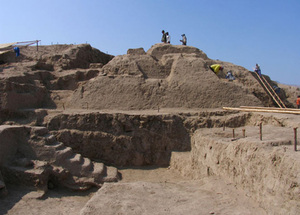What may be the oldest documented mural in the Americas has been found inside a 4,000-year-old temple near the Peruvian coast, researchers reported yesterday.
The discovery, made by Peruvian archaeologist Walter Alva in a looted site known as Ventarrón, is located in Peru's Lambayeque valley, some 500 miles (804 kilometers) from the capital, Lima.
"We have found what we believe is the oldest mural in the Americas," Alva, director of the Royal Tombs of Sipán Museum, told
National Geographic News in an interview.
At a Peruvian government conference this weekend, Alva announced that carbon dating conducted in the United States shows that the mural and temple are 4,000 years old.
Ventarrón is located 12 miles (20 kilometers) from Sipán, the religious and political heart of the ancient Moche people, who flourished near Peru's northern coastlands from around A.D. 1 to A.D. 700.

|
| ©Ignacio Alva/Reuters
|
Archaeologists work at the clay temple Ventarrón in the northern city of Lambayeque, Peru, on November 10, 2007.
A hidden staircase in the 4,000-year-old temple has revealed what may be the oldest documented mural in the Americas, researchers reported yesterday.
|
Alva, who discovered that important archaeological site in the 1980s, said the Ventarrón mural and structures predate Sipán by nearly 2,000 years.
Sophisticated ArtistryThe structures were made from "primitive" materials but were relatively sophisticated in some ways, he said.
His team found a wall painting - which depicts a deer caught in a net - after discovering a staircase leading up to a hidden altar.
Another red-and-white wall painting was also found.
The stairway caught their attention because it is an architectural oddity in that region, Alva said. Also strange, the temple was built from blocks of river sediment rather than adobe or stone, he said.
"These construction characteristics have not been seen before in northern Peru," he said.
"Though the construction materials were very primitive, the mural and structures themselves are surprisingly sophisticated and artistically elaborate."
The site was built by a culture that predated other pre-Columbian cultures such as the Cupisnique, Chavinoide, Chavín, and Moche, Alva said.
Early CultureHe said some of the artifacts found in Ventarrón suggest that the region of Lambayeque was a cultural exchange point between Peru's Pacific coast and other regions.
His team, for example, found ceremonial offerings including the skeletons of a parrot and a monkey that would have come from Peru's jungle regions.
They also found shells that would have come from coastal Ecuador, he said.
Michael E. Moseley, an anthropologist at the University of Florida, was not involved in the research.
Dr. Alva has a track record for unique discoveries," Moseley said, "and his latest unearthing of ancient temple murals greatly enlightens understanding of the vibrance of ceremonialism in Native America millennia ago.
Luis Jaime Castillo, an archaeologist at Peru's Catholic University in Lima, said the finding is important.
"It suggests that societies in their formative period, the period before complex societies came into being, extended into the northern reaches of Peru earlier than we thought."
The finding was also fortuitous given the site's recent history.
Over the years, Ventarrón has been almost totally destroyed by locals digging for materials to make adobe buildings and livestock corrals.
What's more, Alva said the tomb was ransacked in 1990 and 1992, but the raiders failed to find the staircase leading to the temple.
Reader Comments
to our Newsletter